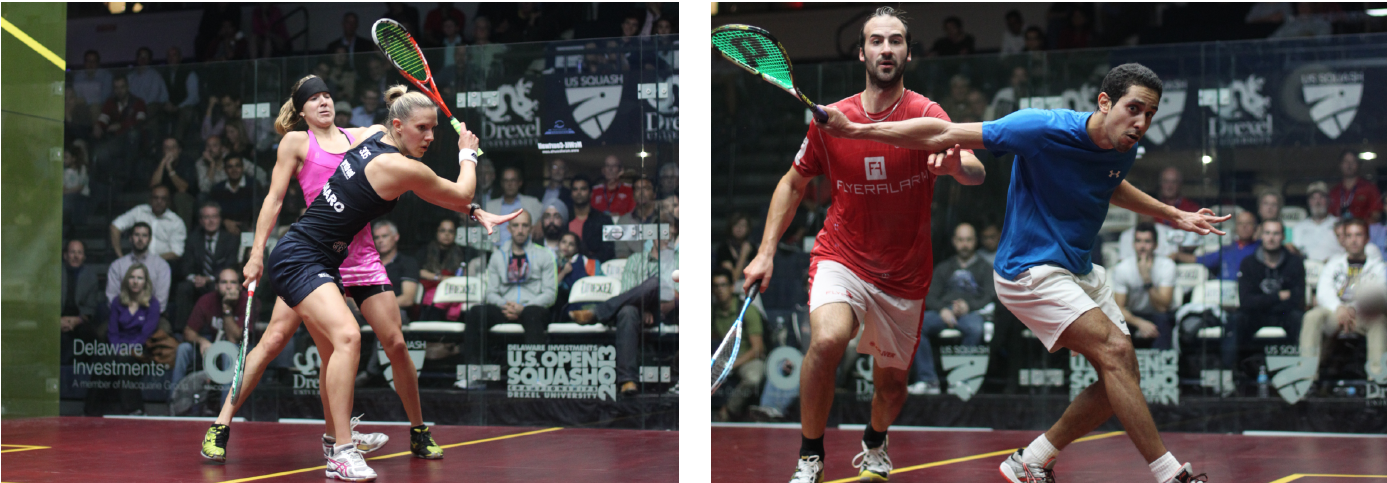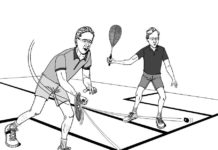By Barry Faguy
HEY REF! I was reading the new 2014 rules and was having a tough time figuring out the difference between ‘excessive’ and ‘exaggerated’ swings. Help!?
Welcome to the club. Most rules deal with the assumption that a player’s swing is reasonable—meaning that it does “not extend more than is necessary” for the intended shot. This is generally understood to mean using primarily a vertical rather than horizontal plane of travel (for both the backswing and follow-through)—and a bent elbow where possible (avoiding a straight arm). So an unreasonable swing (excessive or exaggerated) would be one that does indeed extend more than necessary.
In a nutshell, here is how I see the proper use of those two words:
- The first provision found under ‘Excessive swing’ mandates a “no let” if the striker is the one who makes the appeal when encountering interference while using such a big swing. The rule is, therefore, interpreting such a swing to be ‘created interference’ (meaning that it was deliberately artificial—essentially intended as an attempt to cheat). Previously, with an excessive swing (sometimes due to incompetence, sometimes just inadvertence), the rules simply precluded a stroke to the striker. The 2014 rules no longer allow for that—and I fear that if strictly applied, would disproportionally penalize low level players where this kind of thing is common.
- I suspect, however, that refs will continue to treat those latter situations as we always have—meaning that big swings, typically associated with incompetence or inadvertence, will result in lets—and a stroke will never be awarded to the striker for that kind of swing. Of course, deliberate attempts to generate artificial interference with a big swing should always be met with a no let.
- Another provision that uses the word ‘excessive’ deals with a request for let by the non-striker when faced (often literally ‘in the face’) with an excessive swing by the striker. In such cases, the non-striker may then request a let (based on ‘access’ interference) when it becomes that player’s turn to be the striker.
So, if we compare all the above, it seems that if the exact same thing happened, and the striker was the player who made the request for a let (our first provision above), it would be a no let. However, if you change the requesting player, for some strange reason it changes the decision.
- Related to all this is another provision that uses a different word—‘exaggerated’—and it is, unfortunately, as I see it, somewhat of an embarrassment. It mandates a let for a player who, having encountered a (likely) minor interference to the swing, then deliberately ‘exaggerated’ it to artificially generate a stroke. That sure looks like unethical behavior, and any player attempting such a ploy should only receive a no let—but that’s just me.
HEY REF! My opponent was given time to change her racquet because she felt the grip was getting slippery. Does that qualify as a legitimate equipment change?
Unfortunately, the current 2014 rules only specify “damaged” equipment as qualifying for time to do this. Decision making in this regard is made easier if we keep in mind the original intent of including such a rule (as stated in the 2001 edition)—and that was to prevent one player from gaining an unfair rest interval. The guideline from 2001 allowed a number of things to justify changing equipment, including considerations of safety (e.g., slippery grip), as long as no ulterior motive was suspected, such as attempting to gain time to recover from fatigue.






